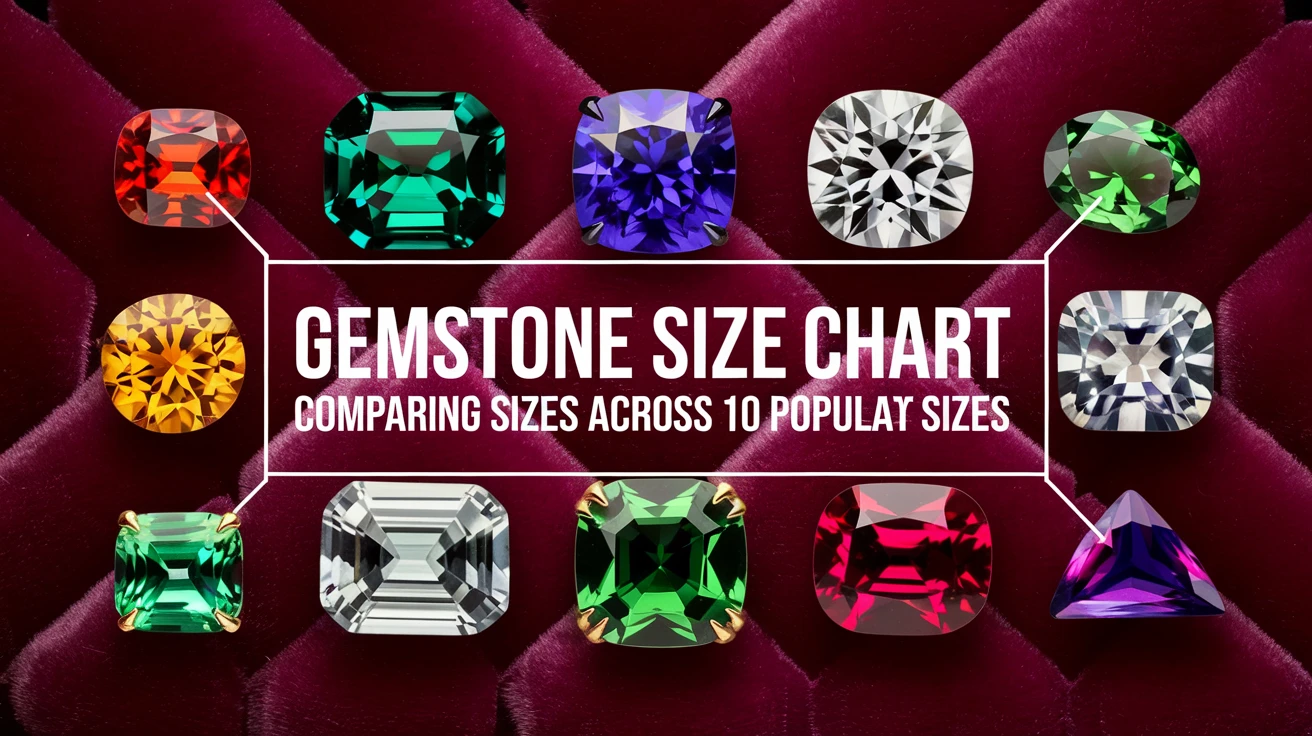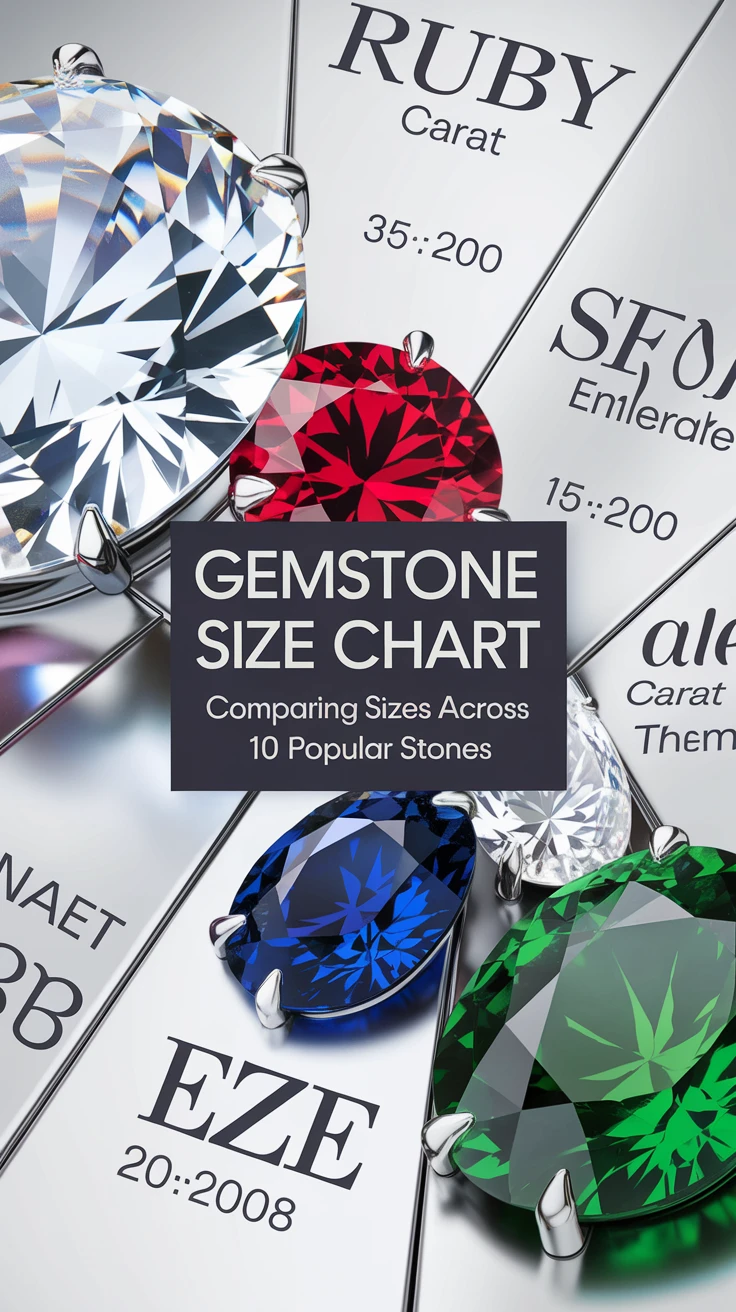
When it comes to selecting the perfect gemstone, size matters just as much as color and clarity. Our gemstone size comparison chart guide will help you understand how different precious stones measure up against each other, ensuring you make an informed decision for your next jewelry purchase.
Before diving into specific stones, let’s understand some basic principles that affect gemstone sizing:
- Carat weight doesn’t always translate to the same visible size across different stones
- Density variations mean some stones look larger at the same weight
- Cut and shape significantly impact apparent size
- Different gemstones naturally occur in different size ranges
| Stone Type | 1 Carat Size (mm) | Relative Density | Typical Size Range |
|---|---|---|---|
| Diamond | 6.5mm | 3.52 | 0.25-5 ct |
| Sapphire | 6.0mm | 4.00 | 0.5-5 ct |
| Ruby | 6.0mm | 4.00 | 0.5-3 ct |
| Emerald | 6.5mm | 2.76 | 0.5-5 ct |
| Tanzanite | 6.7mm | 3.35 | 1-10 ct |
1. Diamonds: The Standard Bearer
Diamonds serve as the benchmark in our gemstone size comparison chart, as they’re the most widely known precious stone. A one-carat round brilliant diamond typically measures 6.5mm in diameter.
- Round brilliant cut: 6.5mm at 1 carat
- Princess cut: 5.5mm at 1 carat
- Oval cut: 7.5mm x 5.5mm at 1 carat
- Cushion cut: 6.0mm at 1 carat
Understanding diamond sizes helps create a reference point for other gemstones. Their consistent cutting standards make them ideal for comparison.
Pro tip: When comparing diamond sizes, remember that depth percentage significantly affects face-up appearance.
2. Sapphires: Dense Beauty
Sapphires have a higher density than diamonds, meaning they appear slightly smaller at the same carat weight. This is crucial to consider when reviewing a gemstone size comparison chart.
- Round cut: 6.0mm at 1 carat
- Oval cut: 7.0mm x 5.0mm at 1 carat
- Cushion cut: 5.8mm at 1 carat
- Emerald cut: 7.0mm x 5.0mm at 1 carat
Sapphires are often cut to retain color, which can affect their face-up size appearance.
Pro tip: Look for elongated cuts in sapphires to maximize apparent size.
3. Rubies: Compact Treasures
As members of the corundum family like sapphires, rubies share similar density properties and sizing characteristics.
- Round cut: 6.0mm at 1 carat
- Oval cut: 7.0mm x 5.0mm at 1 carat
- Pear cut: 7.5mm x 5.0mm at 1 carat
- Cushion cut: 5.8mm at 1 carat
Large, natural rubies are exceptionally rare, making sizes above 3 carats particularly valuable.
Pro tip: When selecting rubies, prioritize color depth over size for the best value.
4. Emeralds: Lighter and Larger
Emeralds have a lower density than diamonds, resulting in a larger appearance at the same carat weight. This makes them stand out in any gemstone size comparison chart.
- Emerald cut: 7.0mm x 5.0mm at 1 carat
- Oval cut: 7.5mm x 5.5mm at 1 carat
- Round cut: 6.5mm at 1 carat
- Cushion cut: 6.3mm at 1 carat
The traditional emerald cut maximizes face-up appearance while protecting the stone from damage.
Pro tip: Choose step-cut emeralds for the most impressive size appearance.
5. Tanzanite: Modern Marvel
Tanzanite’s density allows for impressive size presentation, making it a popular choice for statement pieces.
- Oval cut: 7.2mm x 5.2mm at 1 carat
- Cushion cut: 6.2mm at 1 carat
- Round cut: 6.7mm at 1 carat
- Princess cut: 5.7mm at 1 carat
Tanzanite is often available in larger sizes, making it perfect for dramatic jewelry pieces.
Pro tip: Consider elongated cuts in tanzanite to maximize the stone’s pleochroic effect.
6. Amethyst: Purple Proportions
Amethyst’s lower density makes it appear larger than many precious gems of the same weight.
- Round cut: 6.8mm at 1 carat
- Oval cut: 7.8mm x 5.8mm at 1 carat
- Emerald cut: 7.5mm x 5.5mm at 1 carat
- Cushion cut: 6.5mm at 1 carat
Amethyst frequently occurs in larger sizes, allowing for bold statement pieces.
Pro tip: Large amethysts are relatively affordable, making them excellent choices for cocktail rings.
7. Opal: Unique Sizing
Opals are often measured by dimensions rather than carat weight due to their variable density and composition.
- Typical cabochon: 8mm x 6mm
- Common oval: 10mm x 8mm
- Standard round: 7mm
- Boulder opal: Various sizes
Opal sizing is more focused on the display of play-of-color than specific weight measurements.
Pro tip: When selecting opals, focus on the quality of color play rather than size alone.
8. Topaz: Versatile Volumes
Topaz offers excellent size per carat due to its relatively lower density.
- Round cut: 6.7mm at 1 carat
- Oval cut: 7.6mm x 5.6mm at 1 carat
- Emerald cut: 7.4mm x 5.4mm at 1 carat
- Cushion cut: 6.4mm at 1 carat
Available in large sizes, topaz provides excellent value for statement jewelry.
Pro tip: Blue topaz often offers the best size-to-price ratio among blue gemstones.
9. Garnet: Dense and Dramatic
Garnets vary in density by species, affecting their size appearance in our gemstone size comparison chart.
- Round cut: 6.2mm at 1 carat
- Oval cut: 7.2mm x 5.2mm at 1 carat
- Cushion cut: 6.0mm at 1 carat
- Emerald cut: 7.0mm x 5.0mm at 1 carat
Different garnet varieties may appear slightly different in size due to density variations.
Pro tip: Rhodolite garnets often appear larger than almandine garnets of the same weight.
10. Aquamarine: Ocean Dimensions
Aquamarine’s lower density creates impressive sizes per carat weight.
- Round cut: 6.8mm at 1 carat
- Emerald cut: 7.5mm x 5.5mm at 1 carat
- Oval cut: 7.7mm x 5.7mm at 1 carat
- Cushion cut: 6.5mm at 1 carat
Aquamarine is often found in larger sizes, making it perfect for statement pieces.
Pro tip: Choose emerald cuts for aquamarine to maximize both size appearance and color saturation.
Key Takeaways
- Carat weight translates differently across gemstone varieties
- Dense stones appear smaller at the same weight
- Cut and shape significantly impact apparent size
- Consider both size and density when comparing stones
- Use our gemstone size comparison chart as a reference guide
Conclusion
Understanding gemstone sizes through our comprehensive gemstone size comparison chart helps make informed jewelry purchases. Remember that while size is important, it should be balanced with other factors like color, clarity, and cut quality. Use this guide as a reference point, but always view stones in person when possible for the most accurate size perception.
Frequently Asked Questions
How do gemstone sizes compare to everyday objects?
A 1-carat round diamond (6.5mm) is approximately the size of a green pea. A 2-carat stone is about the size of a small chickpea.
Why do some gemstones appear larger than others at the same carat weight?
This is due to differences in density between gemstone species. Less dense stones will appear larger at the same weight.
What’s the relationship between carat weight and millimeter size?
The relationship varies by gemstone density, but generally, a 1-carat round stone ranges from 6.0-6.8mm depending on the species.
How does cut affect the apparent size of a gemstone?
Elongated cuts like oval and marquise appear larger than round cuts of the same carat weight. Deep cuts appear smaller from above.
What’s the average size for engagement ring gemstones?
The average engagement ring center stone is typically between 0.8 and 1.2 carats, though this varies by region and preference.

